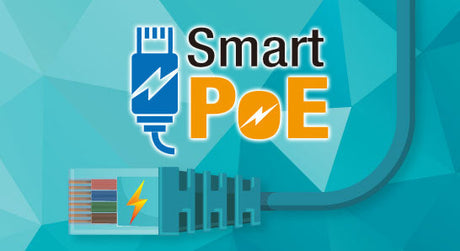Why smarter PoE deployment is critical for industrial networks
Industrial Ethernet networks are expanding rapidly with the rise of automation, surveillance, and edge computing. Power over Ethernet (PoE) is essential for powering devices like IP cameras, wireless access points, and sensors—without separate power lines.
However, deploying PoE in industrial environments presents challenges:
- Limited input voltage (12/24 VDC)
- No real-time device visibility
- Unresponsive powered devices (PDs)
- High and variable power demands from IEEE 802.3bt devices
Moxa’s Smart PoE switches are engineered to solve these problems—making industrial networks more resilient, efficient, and scalable.
1. Voltage Compatibility: Simplify deployment with built-in DC power boost conversion
Most PoE switches require 48 VDC input, but many industrial sites only offer 12 or 24 VDC. External converters add cost and complexity. PoE switches equipped with built-in DC-DC boost converters can internally raise 12/24 VDC to 48 VDC, eliminating the need for external conversion hardware. This simplifies deployment and improves reliability, particularly in space-constrained or remote installations.
Considerations
Power efficiency: Boosting voltage may reduce conversion efficiency. It’s important to verify that the switch can still meet output requirements.
EMC/EMI compliance: Boost conversion can increase emissions. Devices should meet industrial-grade standards such as EN 55032/35 and CISPR 32.
Solution: Moxa’s Smart din-rail PoE switches (e.g., EDS-4000 Series) feature built-in DC-DC boost converters, internally converting 12/24 VDC to 48 VDC.
2. Real-Time Visibility: Monitor and troubleshoot with Managed PoE Switches
Unmanaged switches offer limited insight into power delivery and device status. This can hinder fault diagnosis and delay recovery, especially in distributed or unmanned environments.
Managed PoE switches provide real-time data on power status, voltage levels, and PD classification. For larger deployments, network management platforms can aggregate data across multiple switches, visualise power distribution, and issue alerts via SNMP or integration with collaboration tools.
Considerations:
Granularity: Device-level metrics such as power status, voltage, and PD classification help isolate faults quickly.
Scalability: Centralised monitoring tools improve operational efficiency across multi-site networks.
Solution: Moxa’s smart/managed ethernet switches provide real-time monitoring of power status, voltage, and PD classification. For large networks, Moxa MXview One network management software centralises data and sends alerts via SNMP or Microsoft Teams.
3. Downtime caused by unresponsive powered devices
Powered devices such as cameras or access points may occasionally freeze or become unresponsive. Without remote reboot capabilities, engineers are often forced to perform manual resets onsite, resulting in unnecessary downtime and maintenance costs.
PoE switches with auto-recovery functions can detect when a PD fails to respond and automatically power-cycle the device. This reduces the need for manual intervention and helps maintain network continuity.
Considerations:
Trigger thresholds: Configurable response times and detection intervals allow tailored recovery logic.
Event logging: Helps identify recurring issues and prevent false resets.
Solution: Moxa's Smart PoE switches include auto-recovery functions that detect unresponsive PDs and automatically power-cycle them.
4. Power budget constraints with IEEE 802.3bt devices
The IEEE 802.3bt standard supports up to 90 W per port, enabling high-power applications. However, actual device consumption often varies, making static power allocation inefficient and potentially wasteful.
To make better use of available power, Moxa Smart PoE switches can operate in two modes:
Allocated Mode: Reserves power based on PD classification
Consumed Mode: Allocates power based on actual usage. Consumed Mode allows more devices to operate within the same power budget, improving efficiency and reducing the risk of overprovisioning.
Conclusion
Industrial PoE deployment is no longer a plug-and-play exercise. Engineers must navigate voltage constraints, visibility gaps, device reliability, and power management challenges to ensure robust and scalable network performance.
By adopting switches that support wide input voltage ranges, offer real-time monitoring, enable automated recovery, and optimise power allocation, system integrators can build networks that are more resilient, efficient, and future-ready.
































